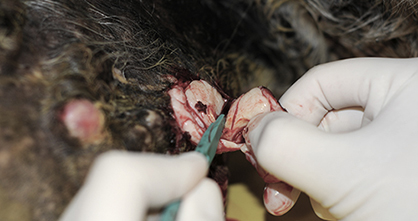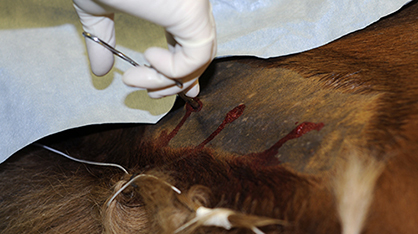Research Shows Sarcoid Vaccination in Horses is Effective
Penn Vet
By: Louisa Shepard
Autologous vaccination is a safe, quick, and inexpensive method of treating sarcoid tumors in horses, according to research by veterinarians at Penn Vet’s New Bolton Center.
The autologous vaccine involves removing a sarcoid from a horse, and implanting pieces back into that horse’s neck.
Dr. David Levine, Assistant Professor of Clinical Large Animal Surgery, and his team researched the safety and effectiveness of the vaccination on sarcoid lesions last year. Levine described the research at the 2015 American Association of Equine Practitioners convention in December.
“The success rate and the owner satisfaction are very high with this treatment, which is inexpensive and easy to do, with very few complications,” Levine said. “This is one more tool in our arsenal to treat sarcoids, which can be very challenging.”
The common sarcoid appears as a wart-like growth and usually is not harmful. However, these lesions are often difficult to treat, often reappearing after removal.
The team evaluated 18 horses with sarcoids that underwent an autologous vaccination procedure at New Bolton Center from 2009 to 2014. The procedure involved removing the sarcoid and cutting it into 3 mm cubes. The cubes were placed into liquid nitrogen for 10 minutes to kill and prepare the sarcoid cells.
Then, two to four thawed sarcoid fragments were surgically inserted into different sites in the horse’s neck, an easily accessible place on the standing horse that has plenty of muscle. The fragments work as a vaccine, prompting the horse’s system to produce antibodies against the sarcoids.
Of the 18 horses in the study, 16 were available for a follow-up examination. Those exams were conducted, on average, 10 1/2 months after the procedure.
- 11 (68.8%) cases resolved completely;
- 15 (93.8%) experienced a decrease in the size of the sarcoids;
- 12 (75%) experienced a decrease in the number of sarcoids;
- 7 (43.8%) experienced complications (swelling)
The results showed 75% of owners were satisfied with the results and 25% of owners were satisfied with the procedure, but not with the complications.
Levine noted that it can take up to six months for the sarcoids to start to regress, and recommends that owners and veterinarians continue to treat the remaining tissue post-vaccination with an anti-tumor medication until resolved.
Historically, veterinarians have used many modalities to treat equine sarcoids, most commonly surgical removal, which has a 50-64% recurrence rate. Other methods include cryotherapy (freezing), interstitial brachytherapy (radiation), chemotherapy (cisplatin), Imiquimod anti-tumor medication, and Xxterra herbal paste.












